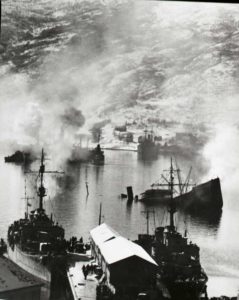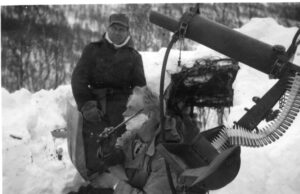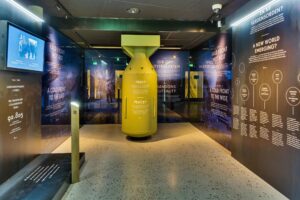
Two of the ten German destroyers dock after taking part in the second Naval Battle in Narvik, April 10th 1940
We welcome you to learn more about the Narvik campaign, the Battle of Narvik, and WWII during your visit at Narvik War Museum. Narvik War Museum is owned and operated by the Narvik War and Peace Centre Foundation, that disseminate, document, and research issues of war, peace, and conflict.
The Narvik Campaign – the Battle of Narvik
In April 1940, the battling parties in Europe all look to a town far to the north: From Narvik, iron ore from Sweden is shipped all over the world. Iron ore that can keep the German war machine going, iron ore that under British control can hinder its continuance. April 9th 1940, Narvik is invaded by Nazi-Germany. April 10th and 13th, the great powers of Nazi-Germany and Great Britain engage in one of the largest Naval Battles to ever take part in the Atlantic Ocean – the Battle of Narvik has begun
Narvik Makes its Mark on the Map
When the German invasion happens April 9th 1940, the Norwegian battleships “Eidsvold” and “Norge” are positioned close to Narvik. The old battleships are swiftly sunk by a top modern German fleet as the German fleet lurk its way into the Ofotfjord, under the cover of a snowstorm. Narvik falls into German hands – some surrender, others fight back. When the German Kriegsmarine and the British Royal Navy engage in intense battles in the Ofotfjord the following days, both parties suffer massive losses – losses that will affect all battles to come. Take a closer look at the battles at Narvik War Museum’s audio-visual platform, “the Iron Ore Table”, and exhibited artifacts, they will help paint the picture for you.
62 Days of War

The Mountain War. Hygiene is important, even in the field
Norwegian soldiers on neutrality guard and at mobilisation takes on the battle in the mountains. Allied forces from Great Britain, France and Poland come to aid. Together, they fight a German army trying to gain control over Narvik and strategic areas in the region. The Germans are forced into a smaller and smaller area, and Norwegian and Allied forces gain back control over Narvik May 28th. The German troops find themselves forced up against the border between Norway and Sweden, ready for leaving Norway through Sweden. It is Hitler’s first strategic loss! But then the Allied forces leave Northern Norway for the Western Front.
After 62 days of fierce battles in the fjords and mountains, the declaration of capitulation takes place June 10th 1940. 64 ships, 86 planes, and 8500 lives are lost during the Narvik Campaign. Differences in force and equipment, uniforms and weapons become evident when visiting our exhibitions. Graphic illustrations show how Allied forces still manage to beat the Germans. Now, the civilian population is surrendered to the German occupying force.
Five Hard Years of Occupation
The Germans take over and introduce many sanctions. They occupy homes, are encouraged to impregnate Norwegian women, and establish over 600 prison camps for Norwegian and foreign prisoners. The civilian population is faced with difficult choices: Are you to agree or disagree with the German occupying force? Restrictions on food and other necessary items are hard, people experience increasing levels of uncertainty and control, and around them are horrendous prison camps where humans are severely mistreated. But life must move on; babies are being born, providing food and clothing requires creativity, and numerous companies enter into cooperation with the Germans to keep the wheels turning. In the exhibitions, the years of occupation are conveyed through artefacts, videotaped eyewitness accounts and writings on both walls and screens.

Copy of the atomic bomb “Little Boy”
Bombing to Make Peace?
Norway and Narvik are liberated from the German iron heel May 8th 1945 – peace has arrived! Then the treason and collaboration trials begin. Close to 93,000 Norwegians are accused of choosing the German side. Some are acquitted, others are punished, for what? It is the last time Norway practice death penalty. In other parts of the world, war ravages on. It ends when USA drops atomic bombs on the Japanese cities of Hiroshima and Nagasaki in August 1945. In the exhibitions, you will find a copy of the Little Boy-bomb that hit Hiroshima, containing an atomic force so fierce that we still see the consequences.
But can we bomb our way to peace? And what part does Norway play in war now? During WWII, the different parties were clear-cut, who are “We” and “the Others” today? In the last part of the museum, “Zona”, you will meet the gray areas of war and conflict of today, where Norway and other countries take part. It is a place for thoughts and reflections, where the aim is not to find defined answers, but challenge what we consider established truths.
Welcome to Narvik War Museum!
Buy your admission to the museum online at visitnarvik.com